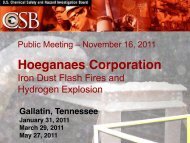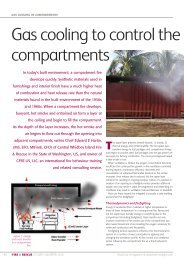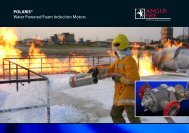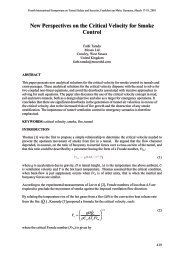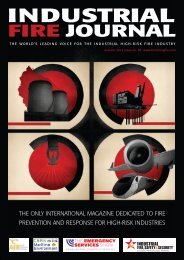fire protection of concrete structures exposed to fast fires
fire protection of concrete structures exposed to fast fires
fire protection of concrete structures exposed to fast fires
Create successful ePaper yourself
Turn your PDF publications into a flip-book with our unique Google optimized e-Paper software.
Fourth International Symposium on Tunnel Safety and Security, Frankfurt am Main, Germany, March 17-19, 2010<br />
FIRE PROTECTION OF CONCRETE STRUCTURES EXPOSED TO<br />
FAST FIRES<br />
Pierre Pimienta *, Octavian An<strong>to</strong>n **, Jean-Chris<strong>to</strong>phe Mindeguia *, Romuald Avenel *<br />
Heidi Cuypers **, Eric Cesmat *<br />
* CSTB – Scientific and Technical Center for Construction, University <strong>of</strong> Paris-Est - 84 Avenue Jean<br />
Jaurès, 77447 Marne la Vallée Cedex, France (contact: pierre.pimienta@cstb.fr)<br />
** PRTC N.V. - Bormstraat, 24 B-2830 Tisselt, Belgium (contact: h.cuypers@prtc.be)<br />
KEYWORDS: Concrete spalling, <strong>fire</strong> protective panels, calcium alumina silicates engineered matrix<br />
for high performing <strong>fire</strong> <strong>protection</strong> <strong>of</strong> <strong>concrete</strong>s.<br />
ABSTRACT<br />
The aim <strong>of</strong> this research is <strong>to</strong> assess, through a scientific experimental program, the behaviour under<br />
the increased hydrocarbon temperature/time curve, <strong>of</strong> <strong>concrete</strong> <strong>structures</strong> protected by calcium<br />
alumina silicates panels developed and produced by a special mineral and matrix engineering<br />
technology for a resistance <strong>to</strong> these conditions <strong>of</strong> temperature.<br />
The principal investigations on this research are focussed on: the influence <strong>of</strong> the thickness <strong>of</strong> the<br />
<strong>protection</strong> on the temperature gradient and behaviour <strong>of</strong> the <strong>concrete</strong>; the nature <strong>of</strong> the <strong>concrete</strong> and in<br />
particular the nature <strong>of</strong> the aggregates which impacts on the thermal diffusivity <strong>of</strong> the <strong>concrete</strong> and the<br />
sensitivity with respect <strong>to</strong> spalling, the implementation or not <strong>of</strong> a compressive stress on bot<strong>to</strong>m fibre<br />
<strong>of</strong> the slab <strong>exposed</strong> <strong>to</strong> <strong>fire</strong>.<br />
1. Introduction<br />
The construction pr<strong>of</strong>essionals pay a particular interest <strong>to</strong> the behaviour <strong>of</strong> <strong>concrete</strong> <strong>structures</strong> in <strong>fast</strong><br />
<strong>fire</strong>s conditions and particularly in tunnels. This interest was jumping at a higher degree <strong>of</strong> concern<br />
following dramatic events encountered in road and railways tunnels in the recent decade and largely<br />
informed by different media [1]. Numbers <strong>of</strong> research studies concerning the behaviour <strong>of</strong> different<br />
<strong>concrete</strong> <strong>structures</strong> were performed, experimentally from small <strong>to</strong> big scale full systems testing in real<br />
exposure conditions [2], [3] or by mathematical modelling [4], [5]. Meanwhile, the exact mechanisms<br />
controlling the behaviour <strong>of</strong> <strong>concrete</strong> in <strong>fast</strong> <strong>fire</strong> conditions are still not well known; and this is due <strong>to</strong><br />
the complexity <strong>of</strong> parameters playing a role in these scenarios. Still <strong>to</strong>day, experimentation is then the<br />
only reliable way <strong>of</strong> assessing the <strong>fire</strong> resistance <strong>of</strong> a <strong>concrete</strong> structure.<br />
The most apprehended phenomenon is the spalling <strong>of</strong> the <strong>concrete</strong> when <strong>exposed</strong> <strong>to</strong> a <strong>fast</strong> firing and<br />
particularly in tunnels where temperatures grow very <strong>fast</strong>, reaching in few minutes high values as<br />
1300°C and even more [6]. Spalling can take several aspects but always leading <strong>to</strong> the loss <strong>of</strong> a part <strong>of</strong><br />
the structure and the loss <strong>of</strong> the mechanical resistance for the remaining <strong>concrete</strong> [7]. Between the<br />
hypotheses on the process leading <strong>to</strong> spalling, two hypotheses are largely considered <strong>to</strong>day: the<br />
thermo-mechanical one that is essentially based on the differential dimensional constraints developed<br />
during exposure <strong>to</strong> high temperature [8], [9], and the thermo-hydric one that considers the pores water<br />
vapour pressures developed when the structure is <strong>exposed</strong> <strong>to</strong> a <strong>fast</strong> firing as responsible for the<br />
physical destruction <strong>of</strong> the <strong>concrete</strong> [10], [11].<br />
In this study we chose <strong>to</strong> focus the spalling study on the analysis <strong>of</strong> the thermal gradients in<strong>to</strong> the first<br />
centimetres <strong>of</strong> the <strong>concrete</strong> slabs. One <strong>of</strong> the main objectives <strong>of</strong> this study was <strong>to</strong> define the critical<br />
thermal gradient for the type <strong>of</strong> <strong>concrete</strong> investigated and test configuration (with or without<br />
constraint).<br />
235
Fourth International Symposium on Tunnel Safety and Security, Frankfurt am Main, Germany, March 17-19, 2010<br />
2. The <strong>fire</strong> <strong>protection</strong> <strong>of</strong> <strong>concrete</strong>: the PROMATECT®<br />
In view <strong>to</strong> better understand the transfer <strong>of</strong> temperature through the <strong>concrete</strong> structure and the relation<br />
<strong>to</strong> the appearance and development <strong>of</strong> spalling, non protected and protected <strong>concrete</strong> constructions<br />
were investigated. The type and thickness <strong>of</strong> the <strong>protection</strong> was between the key <strong>to</strong>ols for a scientific<br />
investigation and definition <strong>of</strong> effective <strong>protection</strong>. This study investigated on the behaviour <strong>of</strong><br />
<strong>concrete</strong> protected mainly by a calcium alumina silicate board, PROMATECT®T, developed and<br />
industrially produced following a special approach – the Mineral and Matrix Engineering – for the<br />
best <strong>fire</strong> <strong>protection</strong> performances for flat as well as curved <strong>concrete</strong> surfaces. Known also as<br />
PROMAXON® Technology (see Figure 1), the manufacturing process <strong>of</strong> the product starts from the<br />
a<strong>to</strong>m level <strong>of</strong> selected raw materials playing with their chemical affinities in view <strong>to</strong> build synthetic<br />
mineral crystal <strong>structures</strong> and aggregate <strong>of</strong> crystals best fitted <strong>to</strong> build the full matrix <strong>of</strong> the product<br />
with the desired texture and structure for the best performances. In this program different thicknesses<br />
were voluntary applied in order <strong>to</strong> involve development <strong>of</strong> different thermal gradients in<strong>to</strong> the<br />
<strong>concrete</strong> slab during the <strong>fire</strong>.<br />
_ 3 µm<br />
Figure 1. Controlled crystal growth and aggregation for specially designed porosity – PROMAXON®<br />
Technology.<br />
In the construction <strong>of</strong> the matrix by this technology, special endothermic phases are integrated in the<br />
crystallization process <strong>to</strong> bring at the desired moment in a <strong>fire</strong> the most effective cooling <strong>of</strong> the<br />
interface with the <strong>concrete</strong> <strong>to</strong> protect. Two type <strong>of</strong> <strong>protection</strong> boards were used in this study -<br />
PROMATECT® H for some particular constructions and PROMATECT® T.<br />
PROMATECT® -H is an au<strong>to</strong>claved calcium silicate board with nominal dimensions <strong>of</strong> 2.5 x 1.25 m,<br />
thickness from 6 <strong>to</strong> 27 mm and a nominal density <strong>of</strong> 870 kg/m³. The matrix <strong>of</strong> H type was developed<br />
<strong>to</strong> satisfy different <strong>fire</strong> <strong>protection</strong> construction requirements.<br />
PROMATECT® -T is a product specially designed for <strong>fire</strong> <strong>protection</strong> applications <strong>of</strong> <strong>concrete</strong><br />
<strong>structures</strong> in tunnels, board with nominal dimensions <strong>of</strong> 2.5 x 1.2 m, thickness from 15 <strong>to</strong> 40 mm and<br />
a nominal density <strong>of</strong> 900 kg/m³. The matrix is based on calcium alumina silicates developed under<br />
controlled crystal growth technology. Mineral and Matrix Engineering concept was used <strong>to</strong> design a<br />
matrix with an optimized cooling action at the right moment during the <strong>fire</strong>.<br />
Between the physical characteristics <strong>of</strong> interest for tunnel applications, PROMATECT® H has<br />
thermal conductivity <strong>of</strong> 0.175 W/mK, 0.212 W/mK for PROMATECT® T. The densities being<br />
similar, the differences are on the textural detail <strong>of</strong> the matrix: H type has a laminar texture when T<br />
type has a monolithic one. Another important characteristic is the specific energy (Cp) that is also a<br />
parameter largely used particularly by those using mathematical modelling approach for the definition<br />
<strong>of</strong> the necessary <strong>protection</strong>(type and thickness) for safe constructions. The value given by<br />
scientific/technical literature is around 1.00 J/gK for calcium silicates or calcium alumina silicates.<br />
Important <strong>to</strong> note is that the value is measured after heating the product up <strong>to</strong> 500 °C and cooled<br />
down. But by such method <strong>of</strong> measuring, all eventual advantages that a specific product can bring for<br />
an efficient and cost advantageous <strong>fire</strong> <strong>protection</strong> can not be seen and exploited (Figure 2, left second<br />
run). This study paid a particular attention <strong>to</strong> this and proposed, by a rigorous parallel experimental<br />
and mathematical modelling, a better procedure for assessing reliable Cp values (Figure 2, right).<br />
236
Fourth International Symposium on Tunnel Safety and Security, Frankfurt am Main, Germany, March 17-19, 2010<br />
specific energy [J/gK]<br />
12<br />
10<br />
8<br />
6<br />
4<br />
2<br />
0<br />
0 100 200 300 400 500 600<br />
CP on sample after<br />
Temperature<br />
stabilisation (second<br />
[°C]<br />
run)<br />
Cp on sample as received (first run)<br />
Specific energy [kJ/kgK]<br />
FEM specific enery PT-T<br />
50000<br />
45000<br />
40000<br />
1st endotherm<br />
35000<br />
30000<br />
25000<br />
2nd endotherm<br />
20000<br />
15000<br />
10000<br />
5000<br />
0<br />
0 100 200 300 400 500 600<br />
Temperature [°C]<br />
Figure 2. On the left, specific energy (Cp) measured after a first heating <strong>to</strong> 500 °C (generally used by modelling<br />
people) and for virgin sample (first run, i.e. with no pre heating). On the right, the endotherms that are<br />
considered in this study for the finite element modelling.<br />
3. Experimental settings<br />
3.1 Testing program<br />
The experimental program <strong>of</strong> this study was jointly carried out at the PRTC labora<strong>to</strong>ry (Promat<br />
Research and Technology Center, Belgium) and at the CSTB labora<strong>to</strong>ry (France). The number <strong>of</strong><br />
tests, depending on the thermal <strong>protection</strong> thickness, type <strong>of</strong> <strong>concrete</strong> and type <strong>of</strong> loading are<br />
summarized in the Table 1. Tests in the two labora<strong>to</strong>ries were done on the same slabs <strong>concrete</strong> and<br />
<strong>protection</strong> systems. The main difference is that the tests that were made at PRTC consisted in<br />
unloaded slabs while tests in CSTB consisted in loaded slabs.<br />
Number <strong>of</strong> tests<br />
Unloaded slabs<br />
(Promat Research and Technology<br />
Center)<br />
Loaded slabs (CSTB)<br />
Protection<br />
thickness [mm]<br />
Calcareous<br />
<strong>concrete</strong><br />
Silico-calcareous<br />
<strong>concrete</strong><br />
Calcareous<br />
<strong>concrete</strong><br />
Silico-calcareous<br />
<strong>concrete</strong><br />
/ = no test<br />
0 1 1 1 1<br />
8 1 1 1 1<br />
12.5 1 1 1 /<br />
15 1 1 1 /<br />
20 / / 1 /<br />
25 / / 1 /<br />
3.2 Concrete mixes<br />
Table 1. Summary <strong>of</strong> the experimental program<br />
For this study, two types <strong>of</strong> <strong>concrete</strong> have been tested. Both <strong>of</strong> them are ordinary <strong>concrete</strong>s<br />
(compressive strength lower than 60 MPa). The only difference between the two formulas comes from<br />
the nature <strong>of</strong> the aggregates. The first <strong>concrete</strong>, that we called B40, is fabricated with calcareous<br />
237
Fourth International Symposium on Tunnel Safety and Security, Frankfurt am Main, Germany, March 17-19, 2010<br />
aggregates. These aggregates are crushed rocks with a content <strong>of</strong> almost 99 % <strong>of</strong> CaO. The second<br />
<strong>concrete</strong>, that we called B40SC, is fabricated with a mix <strong>of</strong> calcareous and siliceous aggregates. These<br />
silico-calcareous aggregates are composed by alluvial semi-crushed sand and limes<strong>to</strong>ne gravels.<br />
Testing two types <strong>of</strong> aggregates allows analysing the <strong>fire</strong> behaviour <strong>of</strong> the most common <strong>concrete</strong>s<br />
that one may use in France. Moreover, previous studies have shown that the behaviour <strong>of</strong> <strong>concrete</strong> at<br />
high temperature is strongly dependant on the nature <strong>of</strong> the aggregates [13].<br />
The composition <strong>of</strong> the two types <strong>of</strong> <strong>concrete</strong>s used for the study is given in Table 2. It is in<br />
conformity with standard NF EN 206.<br />
kg Calcareous <strong>concrete</strong> Silico-calcareous <strong>concrete</strong><br />
CEM II 42.5 R cement 350 350<br />
8/12.5 calcareous gravel 330<br />
12.5/20 calcareous gravel 720<br />
4/8 silico-calcareous gravel 150<br />
8/20 silico-calcareous gravel 890<br />
0/2 sand 845 845<br />
Water 188 188<br />
Superplasticizer 4.31 5.25<br />
W / C ratio 0.54 0.54<br />
28 days Rc [MPa] 39 40<br />
Table 2. Composition <strong>of</strong> the two <strong>concrete</strong>s <strong>of</strong> the study<br />
3.3 Unloaded tests<br />
During the same <strong>fire</strong> test, both <strong>concrete</strong> types (calcareous and silico-calcareous) were tested (see<br />
Figure 3). In parallel with the thermal data collection, a video camera placed inside <strong>of</strong> the furnace was<br />
capturing all moments and brought very useful information <strong>of</strong> the moment and the way <strong>concrete</strong><br />
spalling occurred.<br />
Figure 3. The testing furnace in Promat labora<strong>to</strong>ry (left) and the design <strong>of</strong> the construction for testing (right).<br />
238
Fourth International Symposium on Tunnel Safety and Security, Frankfurt am Main, Germany, March 17-19, 2010<br />
3.4 Loaded tests<br />
Generally, most <strong>of</strong> the <strong>fire</strong>s tests carried out on <strong>concrete</strong> slabs consist in applying a mechanical load<br />
that results in the bending <strong>of</strong> the slabs (involving an initial tensile stress in the slab bed that is <strong>exposed</strong><br />
<strong>to</strong> <strong>fire</strong>). However, previous studies shown that <strong>concrete</strong> spalling can be more severe for compressed<br />
elements. In this study, the influence <strong>of</strong> an initial compressive stress in the slab bed <strong>exposed</strong> <strong>to</strong> <strong>fire</strong><br />
has then been analysed.<br />
For that, an innovative testing procedure has been developed at the CSTB. This facility consists in<br />
bending the slab in such a way that a compressive stress <strong>of</strong> 10 MPa is initially applied <strong>to</strong> the slab bed<br />
that is <strong>exposed</strong> <strong>to</strong> <strong>fire</strong>. Firstly, the <strong>concrete</strong> slab is horizontally placed upon a gas burners furnace. The<br />
geometry <strong>of</strong> the slab is shown in Figure 4. The <strong>exposed</strong> surface <strong>of</strong> the slab is 4490 x 1000 mm² and its<br />
thickness in the "<strong>fire</strong> zone" is 200 mm. Then stiff metal beams (length = 4000 mm) are fixed on each<br />
end <strong>of</strong> the slab. The ends <strong>of</strong> the slab have a greater thickness than in heated zone (350 mm) and are<br />
rigidified by a dense reinforcement. A dead load <strong>of</strong> 1 <strong>to</strong>n is suspended at the end <strong>of</strong> the metal beams.<br />
This system involves the bending <strong>of</strong> the slab in a direction at the opposite <strong>of</strong> the <strong>fire</strong>. This induces<br />
then an initial compressive stress <strong>of</strong> 10 MPa in the inferior bed <strong>of</strong> the slab.<br />
Figure 4. Geometry and principle <strong>of</strong> the "compressive" <strong>fire</strong> test.<br />
3.5 Fire curve<br />
All the tests <strong>of</strong> the study (loaded and unloaded tests) are carried out under the so-called temperature/<br />
time curve "HCM" (for Modified HydroCarbon <strong>fire</strong>, in French), defined by the Technical Instruction<br />
annexed in the circular n° 2000-63 <strong>of</strong> August 25th, 2000.<br />
The thermal program is described by the following relation:<br />
T = 1280. (1-0,325e (-0,167t) -0,675 e (-2,5t) )+ 20<br />
Where T is the furnace inner temperature in [°C] and t the time in [min]. The evolution <strong>of</strong> the<br />
temperature, according <strong>to</strong> the HCM curve is shown in Figure 4 for a duration <strong>of</strong> 3 hours. 1200 °C are<br />
reached in only 10 minutes and 1300 °C are reached after 30 minutes.<br />
239
Fourth International Symposium on Tunnel Safety and Security, Frankfurt am Main, Germany, March 17-19, 2010<br />
1400<br />
Modified HydroCarbon (HCM) <strong>fire</strong> curve<br />
1400<br />
Temperature (°C)<br />
1200<br />
1000<br />
800<br />
600<br />
400<br />
200<br />
0<br />
0 20 40 60 80 100 120 140 160 180 200<br />
Time (min)<br />
Temperature (°C)<br />
1200<br />
1000<br />
800<br />
600<br />
400<br />
200<br />
0<br />
0 2 4 6 8 10 12 14 16 18 20<br />
Time (min)<br />
Figure 5. Evolution <strong>of</strong> the inner furnace temperature under a HCM <strong>fire</strong> curve (on the right, focus on the 20 first<br />
minutes <strong>of</strong> <strong>fire</strong>).<br />
4. Results<br />
In this paragraph, the main results <strong>of</strong> the study are presented. Firstly, we present the analysis <strong>of</strong> the<br />
<strong>concrete</strong> spalling risk depending on different parameters (thermal <strong>protection</strong> thickness, type <strong>of</strong><br />
aggregates, mechanical loading). Then we present an experimental and numerical study attending <strong>to</strong><br />
establish the link between <strong>concrete</strong> spalling and the thermal gradients that is induced in the first<br />
centimetres <strong>of</strong> the <strong>fire</strong>d slab. At last, we present the results <strong>of</strong> the assessment <strong>of</strong> the residual<br />
compressive strength <strong>of</strong> <strong>concrete</strong> in the <strong>fire</strong>d slabs, from drilled cores.<br />
4.1 Concrete spalling<br />
The Table 3 summarizes the results <strong>of</strong> the maximal <strong>concrete</strong> spalling depths that were measured<br />
depending on different parameters such as the thickness <strong>of</strong> the thermal <strong>protection</strong>, the type <strong>of</strong><br />
aggregates and the type <strong>of</strong> mechanical loading. The main observations are as following.<br />
When <strong>concrete</strong> slabs are not thermally protected, <strong>concrete</strong> spalling occurs for any type <strong>of</strong> our tested<br />
<strong>concrete</strong>s (i.e. for both types <strong>of</strong> aggregates) and for any type <strong>of</strong> mechanical loading (i.e. with no<br />
loading or for compressive loading). In that case, <strong>concrete</strong> spalling involves the disappearance <strong>of</strong><br />
<strong>concrete</strong> cover and then the direct exposure <strong>to</strong> <strong>fire</strong> <strong>of</strong> the reinforcement.<br />
For the under sized thermal <strong>protection</strong> boards ( from 8 <strong>to</strong> 15 mm), <strong>concrete</strong> spalling can also occur.<br />
This has been particularly observed during loaded tests. It is very important <strong>to</strong> note that when <strong>concrete</strong><br />
spalling occurred for protected slabs, <strong>concrete</strong> spalling was deeper than for slabs with no <strong>protection</strong><br />
(see Figure 6). This unexpected result clearly indicates that an under sizing <strong>of</strong> the thermal <strong>protection</strong><br />
can involve an important damage <strong>of</strong> the <strong>concrete</strong> structure (with in particular an important exposure <strong>of</strong><br />
the reinforcement <strong>to</strong> <strong>fire</strong>).<br />
For thick enough thermal <strong>protection</strong> (20 and 25 mm in our study), <strong>concrete</strong> spalling is avoided in the<br />
case <strong>of</strong> loaded slabs. This results in a continuous <strong>protection</strong> <strong>of</strong> the reinforcement during the <strong>fire</strong> and<br />
good residual mechanical performances (see § 4.3).<br />
240
Fourth International Symposium on Tunnel Safety and Security, Frankfurt am Main, Germany, March 17-19, 2010<br />
Maximal spalling<br />
depth<br />
Protection<br />
thickness [mm]<br />
Calcareous<br />
<strong>concrete</strong><br />
Unloaded slabs<br />
Silico-calcareous<br />
<strong>concrete</strong><br />
Calcareous<br />
<strong>concrete</strong><br />
Loaded slabs<br />
Silico-calcareous<br />
<strong>concrete</strong><br />
0 55 30 49 85<br />
8 50 0 63 77<br />
12.5 0 0 137 /<br />
15 0 0 130 / 45 /<br />
20 / / 0 /<br />
25 / / 0 /<br />
/ = no test; 0 = no spalling<br />
Table 3. Summary <strong>of</strong> the measurement <strong>of</strong> the maximal spalling depth.<br />
In our study, the influence <strong>of</strong> the type <strong>of</strong> aggregates on <strong>concrete</strong> spalling is not clear. Indeed, for tests<br />
with no mechanical loading, <strong>concrete</strong> spalling is deeper for calcareous <strong>concrete</strong>. Moreover, we<br />
observed for slabs protected with 8 mm boards that <strong>concrete</strong> spalling only occurs for calcareous<br />
<strong>concrete</strong>. On the contrary, for tests with mechanical loading, <strong>concrete</strong> spalling is deeper for silicocalcareous<br />
<strong>concrete</strong>. One important aspect <strong>of</strong> <strong>fire</strong> <strong>concrete</strong> behaviour is the spalling that can occur<br />
during the cooling down <strong>of</strong> the structure and even for a long period after the <strong>fire</strong> (actually, it can be<br />
better seen as a <strong>concrete</strong> departure or a <strong>concrete</strong> fall than a real spalling). In the § 4.3, we will see that<br />
the type <strong>of</strong> aggregates can influence this particular type <strong>of</strong> <strong>concrete</strong> departure.<br />
Observing the results in Table 3, we can say that the initial presence <strong>of</strong> a compressive stress at the<br />
inferior bed <strong>of</strong> the slab is unfavourable regarding <strong>to</strong> <strong>concrete</strong> spalling.<br />
However, for slabs with no <strong>protection</strong>, the influence <strong>of</strong> loading is not that clear: the presence <strong>of</strong> load<br />
only involves deeper spalling for silico-calcareous <strong>concrete</strong>. In the case <strong>of</strong> the calcareous <strong>concrete</strong>,<br />
spalling depth does not seem <strong>to</strong> be influenced by the loading.<br />
In the case <strong>of</strong> under sized thermal <strong>protection</strong> boards (from 8 <strong>to</strong> 15 mm), the presence <strong>of</strong> the loading<br />
leads <strong>to</strong> deeper spalling. In particular, for thermal <strong>protection</strong> <strong>of</strong> 12.5 and 15 mm, <strong>concrete</strong> spalling<br />
only occurs in the case <strong>of</strong> loaded slabs. However, we want <strong>to</strong> emphasize that making a direct link<br />
between <strong>concrete</strong> spalling risk and the presence <strong>of</strong> a compressive loading is not that easy. Indeed,<br />
observations during the <strong>fire</strong> tests led us <strong>to</strong> distinguish two modes <strong>of</strong> rupture resulting on <strong>concrete</strong><br />
spalling:<br />
- 1- <strong>concrete</strong> spalling firstly occurs leading <strong>to</strong> the fall <strong>of</strong> the <strong>protection</strong> board. In such a case,<br />
we could directly link <strong>concrete</strong> spalling <strong>to</strong> the presence <strong>of</strong> a mechanical load,<br />
- 2- thermal <strong>protection</strong> board first falls resulting in a sudden exposure <strong>of</strong> "virgin" <strong>concrete</strong><br />
zones <strong>to</strong> <strong>fire</strong>. This mechanism also leads <strong>to</strong> <strong>concrete</strong> spalling but the influence <strong>of</strong> the<br />
mechanical loading seems <strong>to</strong> be more linked with the mechanical resistance <strong>of</strong> the thermal<br />
<strong>protection</strong> system (board and anchorages) itself. This behaviour has been also observed by<br />
[13].<br />
One main difficulty <strong>of</strong> the study is that these both types <strong>of</strong> rupture mode can occur during the same<br />
<strong>fire</strong> test. Further studies have <strong>to</strong> be performed in order <strong>to</strong> better analyse the influence <strong>of</strong> the<br />
mechanical loading on <strong>concrete</strong> spalling (e.g. by using a high velocity camera during <strong>fire</strong> tests).<br />
241
Fourth International Symposium on Tunnel Safety and Security, Frankfurt am Main, Germany, March 17-19, 2010<br />
0 mm<br />
(49 mm)<br />
8 mm<br />
(63 mm)<br />
12.5 mm<br />
(137 mm)<br />
Figure 6. Mapping and pictures <strong>of</strong> the <strong>exposed</strong> surface after HCM <strong>fire</strong> tests <strong>of</strong> loaded slabs (calcareous<br />
<strong>concrete</strong>) with thermal <strong>protection</strong> <strong>of</strong> 0 (unprotected), 8 and 12.5 mm. Between brackets is the maximal spalling<br />
depth.<br />
4.2 Thermal gradient analysis<br />
The thermal gradients developed in the <strong>concrete</strong> slabs <strong>of</strong> different constructions were determined<br />
experimentally by measuring temperature via thermocouples inserted from the surface in<strong>to</strong> the<br />
<strong>concrete</strong> at every 20 mm up <strong>to</strong> the cold side, and also calculated by finite elements modelling method.<br />
In a first step <strong>of</strong> the study, these values were analysed and compared for each construction tested by<br />
the two labora<strong>to</strong>ries. The thermal properties – thermal conductivity, specific heat and density<br />
evolution with temperature – <strong>of</strong> the <strong>concrete</strong>, were determined following the Eurocode 2 documents<br />
[14]; those <strong>of</strong> the <strong>protection</strong> boards were established by Promat labora<strong>to</strong>ries. The thermal gradient<br />
developed near the <strong>concrete</strong> surface is considered being the most critical one; the values were<br />
expressed as:<br />
Gradient = (T 20mm – T 0mm ) / 20 mm [°C/cm]<br />
Experimental thermal gradient: first <strong>of</strong> all, the values <strong>of</strong> temperatures measured in the two<br />
labora<strong>to</strong>ries were used <strong>to</strong> verify the similarities between the two furnaces as temperature<br />
developments and distribution during each trial (and these in comparison with the common calibration<br />
values <strong>of</strong> furnaces from the two labora<strong>to</strong>ries). Then, the values from the interface (or surface for the<br />
non protected constructions) through the <strong>concrete</strong> were used <strong>to</strong> search the correlation between the<br />
thermal gradients and the presence or absence <strong>of</strong> spalling. It was observed that the temperature values<br />
measured in the <strong>concrete</strong> in both labora<strong>to</strong>ries were in good agreement; on the contrary, the values<br />
measured at the interface by the thermocouples scales (depth zero) were slightly different. The<br />
interface temperatures measured at PROMAT are in better accordance with simulated values (see next<br />
242
Fourth International Symposium on Tunnel Safety and Security, Frankfurt am Main, Germany, March 17-19, 2010<br />
paragraph). Then, they were used for the establishment <strong>of</strong> the thermal gradients for the different tests.<br />
The gradients experimentally determined by this way are presented in Figure 7.<br />
Numerical thermal gradient: calculated thermal values were compared with the measured ones.<br />
Best fitting between the calculated and the measured experimental values was found when the FEM<br />
<strong>to</strong>ok in<strong>to</strong> consideration the dynamic change in thermal properties <strong>of</strong> materials with temperature<br />
increase and particularly the endothermic events (see § 2). The numerical simulations were done<br />
separately for both labora<strong>to</strong>ries and are related with the testing observations (spalling or no spalling<br />
and time <strong>of</strong> spalling). The Figure 7 presents the appearance <strong>of</strong> spalling (or absence <strong>of</strong> spalling) in a<br />
graph giving the relation between the thermal gradients and the thickness <strong>of</strong> the thermal <strong>protection</strong><br />
(including the tests without <strong>protection</strong>). Three distinct cases/zones were defined (Figure 8): zone 1<br />
including the case <strong>of</strong> non protected <strong>concrete</strong> or <strong>concrete</strong> protected with 8 mm PROMATECT® H<br />
developed spalling in both labora<strong>to</strong>ries; a zone 3 includes the cases <strong>of</strong> <strong>concrete</strong> protected with 20 and<br />
25 mm PROMATECT® T boards where no spalling was observed; and in between, a zone 2 that<br />
concerns slabs protected by 12.5 and 15 mm thick PROMATECT® T boards. In this zone, unloaded<br />
experiments demonstrated no spalling while loaded experiments have shown spalling. This is<br />
particularly in this zone that the two different modes <strong>of</strong> failure described at the § 4.1 were observed.<br />
Gradient [°C/cm]<br />
300<br />
250<br />
200<br />
150<br />
100<br />
50<br />
spalling after 2/1.5 min<br />
at CSTB/PRTC<br />
spalling after 20/21 min<br />
at CSTB/PRTC<br />
no spalling at PRTC<br />
damage at CSTB<br />
(32min)<br />
Exp. Gradient at failure time determined by CSTB<br />
FEM gradient at failure time determined by CSTB<br />
Exp. Gradient at failure time determined by PRTC<br />
FEM gradient at failure time determined by PRTC<br />
no spalling at PRTC<br />
no spalling at CSTB<br />
0<br />
damage at CSTB (19min)<br />
no <strong>protection</strong><br />
8mm PT-H<br />
12.5mm PT-T<br />
15mm PT-T<br />
20mm PT-T<br />
25mm PT-T<br />
Type <strong>of</strong> thermal <strong>protection</strong><br />
Figure 7. Relation between thermal gradient, thickness <strong>of</strong> the <strong>protection</strong> and development <strong>of</strong> <strong>concrete</strong> spalling.<br />
Gradient [°C/cm]<br />
300<br />
250<br />
200<br />
150<br />
100<br />
50<br />
Zone 1<br />
0<br />
no <strong>protection</strong><br />
8mm PT-H<br />
12.5mm PT-T<br />
15mm PT-T<br />
20mm PT-T<br />
25mm PT-T<br />
Exp. Gradient at failure time determined by CSTB<br />
FEM gradient at failure time determined by CSTB<br />
Exp. Gradient at failure time determined by PRTC<br />
FEM gradient at failure time determined by PRTC<br />
Zone 2<br />
Zone 3<br />
Type <strong>of</strong> thermal <strong>protection</strong><br />
Figure 8. Definition <strong>of</strong> risk and safety zones; the intermediate zone 2 defines a questioning situation.<br />
4.3 Residual compressive strength <strong>of</strong> <strong>concrete</strong><br />
243
Fourth International Symposium on Tunnel Safety and Security, Frankfurt am Main, Germany, March 17-19, 2010<br />
The assessment <strong>of</strong> the residual mechanical performance <strong>of</strong> <strong>concrete</strong> slabs has been carried out on<br />
drilled cores. The cores were drilled at different locations <strong>of</strong> the slabs several months after the <strong>fire</strong> test<br />
(see Figure 9). The first operation consisted in measuring the height <strong>of</strong> the core, allowing us <strong>to</strong><br />
determine the <strong>concrete</strong> spalling depth (operation in Figure 9). Small disks were then cut from the<br />
cores; the distance "x" from the interface between <strong>concrete</strong> and thermal <strong>protection</strong> board <strong>to</strong> the upper<br />
side <strong>of</strong> the cut disk was noted (operation in Figure 9). At last, a compression test was carried out in<br />
a direction parallel <strong>to</strong> the main heat flow in the slab (operation in Figure 9). The obtained<br />
compressive strength was assumed <strong>to</strong> be representative <strong>of</strong> the residual mechanical performance <strong>of</strong> the<br />
<strong>concrete</strong> at a distance "x" from the interface.<br />
Figure 9. Schematic representation <strong>of</strong> the testing procedure for the assessment <strong>of</strong> the residual compressive<br />
strength on drilled cores from <strong>fire</strong> tested slabs (blue zones correspond <strong>to</strong> ejected <strong>concrete</strong>).<br />
The different spalling depths that were measured on drilled cores (for a same slab, we present the<br />
minimal, maximal and mean measured spalling depths) are presented in Figure 10. The results are<br />
presented for different thermal <strong>protection</strong> board thicknesses. The main observations are as following:<br />
- by comparing the measurements <strong>of</strong> <strong>concrete</strong> spalling that were done just after the <strong>fire</strong> tests<br />
(red curves in Figure 10) and the measurements <strong>of</strong> <strong>concrete</strong> spalling that were done on drilled<br />
cores (i.e. several month after <strong>fire</strong> test), we can observe that the departure <strong>of</strong> cover <strong>concrete</strong><br />
can continue even after a long period following a <strong>fire</strong>. This phenomenon is particularly true in<br />
the case <strong>of</strong> the silico-calcareous <strong>concrete</strong>. This "post-<strong>fire</strong>" <strong>concrete</strong> departure can be explained<br />
by different mechanisms (inverse thermal gradient during cooling down that induces tensile<br />
stresses in the cover <strong>concrete</strong> zones, "re-hydration" or "re-humidification" <strong>of</strong> the <strong>concrete</strong> that<br />
can result in swelling and falling <strong>of</strong> the material…) and appears as a main fac<strong>to</strong>r <strong>to</strong> take in<strong>to</strong><br />
account for the post-<strong>fire</strong> assessing <strong>of</strong> a <strong>concrete</strong> structure. Indeed, this cover <strong>concrete</strong><br />
departure can play a role for the residual mechanical performance <strong>of</strong> the structure (decrease <strong>of</strong><br />
the resistive cross-section) as well for its durability (decrease <strong>of</strong> reinforcement <strong>protection</strong><br />
regarding <strong>to</strong> aggressive fac<strong>to</strong>rs),<br />
- the measurements confirm the tendencies observed just after the <strong>fire</strong> test (see § 4.1): the<br />
absence, or the under sizing <strong>of</strong> the thermal <strong>protection</strong> (from 8 <strong>to</strong> 15 mm in our study),<br />
involves and important spalling <strong>of</strong> cover <strong>concrete</strong>. Moreover, the measurements confirm the<br />
fact that in the case <strong>of</strong> an under sized thermal <strong>protection</strong>, <strong>concrete</strong> spalling can be deeper than<br />
for a slab without <strong>protection</strong>,<br />
- a thermal <strong>protection</strong> that is correctly designed (20 and 25 mm in our study) allows avoiding<br />
<strong>concrete</strong> spalling, even after a long period after the <strong>fire</strong>.<br />
244
Fourth International Symposium on Tunnel Safety and Security, Frankfurt am Main, Germany, March 17-19, 2010<br />
Spalling depth [mm]<br />
120<br />
100<br />
80<br />
60<br />
40<br />
t0 spalling - calcareous<br />
t0 spalling - siliceous<br />
tmini spalling - calcareous<br />
tmini spalling - siliceous<br />
tmean spalling -calcareous<br />
tmean spalling -siliceous<br />
tmaxi spalling - calcareous<br />
tmaxi spalling - siliceous<br />
20<br />
0<br />
0 5 10 15 20 25 30<br />
Thermal <strong>protection</strong> boards thickness [mm]<br />
Figure 10. Measurements <strong>of</strong> the spalling depth <strong>of</strong> <strong>concrete</strong> on drilled cores from <strong>fire</strong>s tested slabs according <strong>to</strong><br />
the thermal <strong>protection</strong> board thickness and the type <strong>of</strong> <strong>concrete</strong> (blue curves). The red curves (t0 spalling)<br />
correspond <strong>to</strong> the measurements on <strong>concrete</strong> slabs just after the <strong>fire</strong> test.<br />
The measurements <strong>of</strong> the residual compressive strength <strong>of</strong> <strong>concrete</strong> at different depths <strong>of</strong> the <strong>fire</strong>d<br />
slabs are presented in<br />
Figure 11. The main observations are as following:<br />
- in the case <strong>of</strong> slabs without thermal <strong>protection</strong> and in the case <strong>of</strong> slabs with under sized<br />
thermal <strong>protection</strong> (from 8 <strong>to</strong> 15 mm in our study), the residual mechanical performance<br />
decreases when approaching the interface between the <strong>concrete</strong> and the <strong>protection</strong> board.<br />
Indeed, residual compressive strengths are twice or three times lower close <strong>to</strong> the interface<br />
than in a zone where we can consider that <strong>concrete</strong> is still "healthy" (at more than 100 mm<br />
from the interface),<br />
- for well designed thermal <strong>protection</strong> (20 and 25 mm in our study), the residual compressive<br />
strength does not vary along the depth <strong>of</strong> the slab. Indeed, the strengths that are measured<br />
close at the interface (these measurements are only possible in that case <strong>of</strong> thermal <strong>protection</strong><br />
since <strong>concrete</strong> spalling does not occur) are quite similar with the ones that are measured in the<br />
"healthy" zone.<br />
60<br />
Residual compressive strength vs <strong>concrete</strong> depth<br />
Compressive stregth [Mpa]<br />
50<br />
40<br />
calcareous_no <strong>protection</strong><br />
30<br />
siliceous_no <strong>protection</strong><br />
calcareous_8 mm<br />
20<br />
siliceous_8 mm<br />
calcareous_15 mm<br />
10<br />
calcareous_20 mm<br />
calcareous_25 mm<br />
0<br />
0 20 40 60 80 100 120 140 160 180 200<br />
interface <strong>concrete</strong> slab /<br />
thermal <strong>protection</strong> board<br />
Concrete depth [mm]<br />
Figure 11. Residual compressive strength <strong>of</strong> <strong>concrete</strong> measured on cut drilled cores at different depth <strong>of</strong> the<br />
<strong>concrete</strong> slab. Results for both types <strong>of</strong> <strong>concrete</strong>s and different thicknesses <strong>of</strong> thermal <strong>protection</strong>.<br />
245
Fourth International Symposium on Tunnel Safety and Security, Frankfurt am Main, Germany, March 17-19, 2010<br />
5. Conclusions<br />
This study was carried out thanks <strong>to</strong> the joint action <strong>of</strong> two labora<strong>to</strong>ries: PRTC in Belgium and CSTB<br />
in France. Its main goal was the optimization <strong>of</strong> the calcium alumina silicates thermal <strong>protection</strong><br />
PROMATECT® for <strong>concrete</strong> <strong>structures</strong> that are <strong>exposed</strong> <strong>to</strong> <strong>fast</strong> <strong>fire</strong>s (HCM <strong>fire</strong> in this study).<br />
Fire tests were then carried out in both labora<strong>to</strong>ries in order <strong>to</strong> analyse the influence <strong>of</strong> several<br />
parameters on <strong>concrete</strong> spalling: thickness <strong>of</strong> the thermal <strong>protection</strong> boards, type <strong>of</strong> <strong>concrete</strong> (2 types<br />
<strong>of</strong> aggregate) and type <strong>of</strong> mechanical loading (no loading and compressive loading). The main<br />
conclusions are as following:<br />
- Under the HCM <strong>fire</strong> curve, all the slabs that were not protected showed important spalling.<br />
One consequence <strong>of</strong> this spalling is the direct exposition <strong>to</strong> <strong>fire</strong> <strong>of</strong> the reinforcement, which<br />
can imply failure <strong>of</strong> the structure. In the same way, if the thermal <strong>protection</strong> is under sized<br />
(from 8 <strong>to</strong> 15 mm in our study), <strong>concrete</strong> spalling can also occur. An important result is that<br />
<strong>concrete</strong> spalling for under sized thermal <strong>protection</strong>s can be more severe than unprotected<br />
slabs.<br />
- A correct design <strong>of</strong> the thermal <strong>protection</strong> (20 and 25 mm in our study) allows avoiding the<br />
<strong>concrete</strong> spalling.<br />
- No clear influence <strong>of</strong> the type <strong>of</strong> aggregate has been observed. Calcareous <strong>concrete</strong> showed<br />
more pronounced spalling than silico-calcareous <strong>concrete</strong> for <strong>fire</strong> tests without loading. The<br />
inverse tendency was observed for loaded <strong>fire</strong> tests.<br />
- The influence <strong>of</strong> the type <strong>of</strong> loading on <strong>concrete</strong> spalling was not easily interpreted. Indeed,<br />
two types <strong>of</strong> failure have been observed during the <strong>fire</strong> tests and both <strong>of</strong> them can occur<br />
during the same test: either <strong>concrete</strong> first spalls involving the fall <strong>of</strong> the thermal <strong>protection</strong>, or<br />
the thermal <strong>protection</strong> system (board + anchorages) falls involving a sudden exposure <strong>to</strong> <strong>fire</strong><br />
<strong>of</strong> virgin <strong>concrete</strong> (and then spalling). Further observations are needed <strong>to</strong> better analyse the<br />
influence <strong>of</strong> the type <strong>of</strong> loading.<br />
In this study, we made a link between <strong>concrete</strong> spalling and the induced thermal gradient in the first<br />
centimetres <strong>of</strong> the slab. This approach is assumed <strong>to</strong> be reliable if one regards the severity <strong>of</strong> such a<br />
<strong>fast</strong> <strong>fire</strong> (HCM curve). Thermal gradient was first assessed in an experimental way, by taking in<strong>to</strong><br />
account the temperature measurements <strong>of</strong> both labora<strong>to</strong>ries at the interface between the <strong>concrete</strong> slab<br />
and the <strong>protection</strong> board and the measurement <strong>of</strong> the temperature at 20 mm in<strong>to</strong> the <strong>concrete</strong> slab.<br />
Temperatures that were measured inside <strong>concrete</strong> appeared very similar between both labora<strong>to</strong>ries<br />
while the interface temperature showed slight differences. The use <strong>of</strong> numerical simulations, by mean<br />
<strong>of</strong> finite elements s<strong>of</strong>tware, allowed us <strong>to</strong> better evaluate the interface temperature and then <strong>to</strong> assess<br />
the thermal gradient in <strong>concrete</strong> at the moment just before <strong>concrete</strong> spalling. By this way, three zones<br />
have been identified:<br />
- Zone 1: in this zone, <strong>concrete</strong> spalling risk is high. In our study, this zone concerns the slabs<br />
without <strong>protection</strong> and the slabs protected with an 8 mm thick board.<br />
- Zone 2: this zone appears <strong>to</strong> be a "grey" zone i.e. no clear conclusion can be made concerning<br />
<strong>concrete</strong> spalling risk. More observations are needed. In our study, this zone concerns the<br />
slabs protected with a 12.5 and 15 mm thick board.<br />
- Zone 3: this zone can be considered as a "safe" zone. No <strong>concrete</strong> spalling is observed during<br />
the <strong>fire</strong>. In our study, this zone concerns the slabs a 20 and 25 mm thick board.<br />
A major aspect <strong>of</strong> the study <strong>of</strong> the behaviour <strong>of</strong> <strong>fire</strong>d <strong>concrete</strong> structure is the assessment <strong>of</strong> the<br />
residual mechanical properties (i.e. just after cooling and after a long period following the <strong>fire</strong>). In this<br />
study, the residual compressive strength <strong>of</strong> <strong>concrete</strong> has been measured on drilled cores that were<br />
taken out from the slabs several months after the <strong>fire</strong> test (only for loaded slabs). An original<br />
experimental method allowed us evaluating the residual mechanical performance <strong>of</strong> the slabs<br />
depending on the thermal <strong>protection</strong> thickness and on the type <strong>of</strong> <strong>concrete</strong> (nature <strong>of</strong> the aggregates).<br />
The main observations are as following:<br />
- An under sizing (from 8 <strong>to</strong> 15 mm in our study), or an absence, <strong>of</strong> the thermal <strong>protection</strong><br />
involves an important decrease <strong>of</strong> the residual mechanical performance <strong>of</strong> the <strong>concrete</strong>. This<br />
is particularly true for cover <strong>concrete</strong>. This loss <strong>of</strong> compressive strength, that we assume <strong>to</strong> be<br />
246
Fourth International Symposium on Tunnel Safety and Security, Frankfurt am Main, Germany, March 17-19, 2010<br />
representative <strong>of</strong> the damage state <strong>of</strong> the structure, implied a decrease <strong>of</strong> the whole structure<br />
resistance and a decrease <strong>of</strong> its durability.<br />
- A correct design <strong>of</strong> the thermal <strong>protection</strong> (20 and 25 mm in our study) allows minimizing the<br />
mechanical damage <strong>of</strong> the whole <strong>concrete</strong> slab during <strong>fire</strong> (even for the cover <strong>concrete</strong>). Then<br />
the advantage <strong>of</strong> these <strong>protection</strong>s not only comes from the suppression <strong>of</strong> <strong>concrete</strong> spalling<br />
risk but also from the preservation <strong>of</strong> the mechanical performances <strong>of</strong> a <strong>fire</strong>d <strong>concrete</strong><br />
structure. This is particularly an advantage in the case <strong>of</strong> <strong>fire</strong>d tunnels, in terms <strong>of</strong> financial<br />
and time needs for the structure repairing.<br />
To conclude, the importance <strong>of</strong> the <strong>fire</strong> <strong>protection</strong> relies on its quality and its thickness. These aspects<br />
are strictly dependent on the product design. In particular, the results that are presented in this paper<br />
can not be directly extended <strong>to</strong> other similar thermal <strong>protection</strong> products, other types <strong>of</strong> <strong>concrete</strong> or<br />
other <strong>fire</strong> curves.<br />
6. Acknowledgments<br />
The authors acknowledge the staff <strong>of</strong> both labora<strong>to</strong>ries for their participation <strong>to</strong> this experimental<br />
research.<br />
7. References<br />
[1] Haack, A. Catastrophic Tunnel Fires - What have we learnt? International symposium on catastrophic tunnel<br />
<strong>fire</strong>s (CTF). Boras, Sweden, 2003.<br />
[2] Jansson R. and Bostrom L. Experimental study on the influence <strong>of</strong> polypropylene fibres on material<br />
properties and <strong>fire</strong> spalling <strong>of</strong> <strong>concrete</strong>. fib task group 4.3 workshop "Fire design o <strong>concrete</strong> <strong>structures</strong> -<br />
from materials modelling <strong>to</strong> structural performance". Coimbra, Portugal, 2007.<br />
[3] Kalifa, P., G. Chéné, and Gallé C. "High-temperature behaviour <strong>of</strong> HPC with polypropylene fibres: From<br />
spalling <strong>to</strong> microstructure." Cement and Concrete Research 31(10): 1487-1499, 2001.<br />
[4] Schrefler, B. A., G. A. Khoury, Gawin D. and Majorana C.E. "Thermo-hydro-mechanical modelling <strong>of</strong> high<br />
performance <strong>concrete</strong> at high temperatures." Engineering Computations 19(7-8): 787-819, 2002.<br />
[5] Ulm, F.-J., P. Acker, and Levy M. "The ``Chunnel'' Fire. II: Analysis <strong>of</strong> Concrete Damage." Journal <strong>of</strong><br />
Engineering Mechanics 125(3): 283-289, 1999.<br />
[6] Mindeguia J.C., "Contribution expérimentale à la compréhension du risqué d'instabilité thermique des<br />
bé<strong>to</strong>ns", PhD thesis, University <strong>of</strong> Pau, France, 2009.<br />
[7] Khoury G.A. and Anderberg Y. Concrete spalling - Review, Fire Safety Design, 2000.<br />
[8] Bazant, Z. P., G. Cusatis, and Cedolin L. "Temperature Effect on Concrete Creep Modelled by<br />
Microprestress-Solidification Theory." Journal <strong>of</strong> Engineering Mechanics 130(6): 691-699, 2004.<br />
[9] Sercombe, J., C. Galle, Durand S.F., and Bouniol P. On the importance <strong>of</strong> thermal gradients in the spalling<br />
<strong>of</strong> high-strength <strong>concrete</strong> 14th Engineering Mechanics Conference Austin, USA, 2000.<br />
[10] Harmathy, T. Z. Effect <strong>of</strong> moisture on the <strong>fire</strong> endurance <strong>of</strong> building elements. Research paper 270. Ottawa,<br />
Division <strong>of</strong> Building Research, 1965.<br />
[11] Phan L.T. High-Strength Concrete at High Temperature: An Overview. Utilization <strong>of</strong> High Strength/High<br />
Performance Concrete, 6th International Symposium. Leipzig, Germany, 2002.<br />
[12] Mindeguia J.C., Pimienta P., Carré H. and La Borderie C., "On the influence <strong>of</strong> aggregate nature on<br />
<strong>concrete</strong> behaviour at high temperature", paper submitted <strong>to</strong> the European Journal <strong>of</strong> Environmental and<br />
Civil Engineering, January 2010.<br />
[13] Bostrom L., Larsen C. K., "Concrete for tunnel linings <strong>exposed</strong> <strong>to</strong> severe <strong>fire</strong> exposure", Fire Technology,<br />
42, 351-362, 2006.<br />
[14] CEN (2004). Eurocode 2: calcul des <strong>structures</strong> en bé<strong>to</strong>n - Partie 1-2: Règles générales - Calcul du<br />
comportement au feu.<br />
247


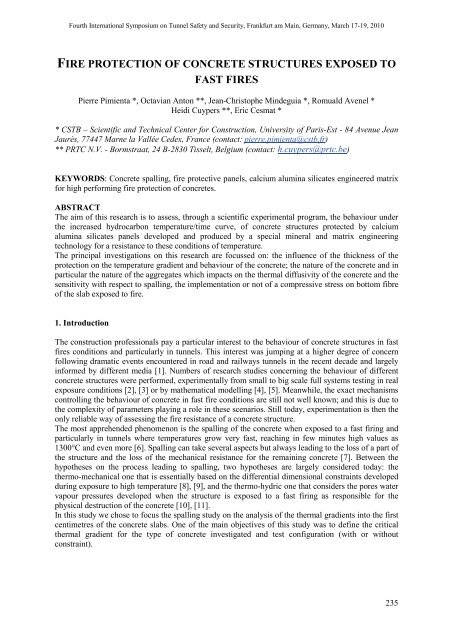
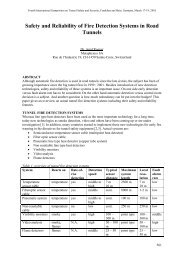
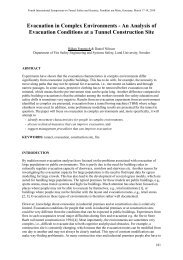
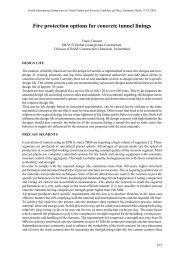
![30-37 TunnelsREV[1]rev.qxd - Industrial Fire Journal](https://img.yumpu.com/22237435/1/184x260/30-37-tunnelsrev1revqxd-industrial-fire-journal.jpg?quality=85)
